This post will explain mechanical bicycle brake compatibility (i.e. brakes with cable actuation, not hydraulic) of both callipers and levers. Hydraulic brakes will be explained in a separate article. For an explanation of terms like the amount of lever cable pull and mechanical advantage, look at this article: Mechanical brakes – working principle.
Before you start, to avoid any misunderstanding:
please take the 5 minutes needed to read the compatibility articles use instructions.
If you have any questions (or additions and corrections), please use the BikeGremlin forum’s compatibility section:
https://www.bikegremlin.net/forums/bike-compatibility/
Table Of Contents (T.O.C.):
- Amount of cable pulled
- Types of brake levers and callipers
- Compatibility of brake levers and callipers
3.1. V-brake (direct-pull, or linear-pull)
3.2. Cantilever (centre-pull)
3.3. Old road levers
3.4. New road levers - Pictures of brake levers and callipers
- Mini V-brake caveats
- Park Tool video demonstration
1. Amount of cable pulled
For compatibility of mechanical brakes, it is important that the amount of cable pulled by the lever matches the required cable pull of brake callipers. If the lever pulls too much cable, the braking force will be very low. If the lever pulls too little cable, callipers won’t reach the braking surface.
For a detailed explanation look at the above already given link: Mechanical brakes – working principle.
Overview of compatibility will be given by brake lever types. Compatible brake callipers for each brake lever type. In chapter 4, there are pictures of each brake lever and calliper type, for easier identification.
2. Types of brake levers and callipers
These are the brake lever types with their amount of cable pull per full lever travel (about 20-degree angle):
- V-brake (also known as direct-pull, or linear-pull), 15 mm
- Cantilever (also known as centre-pull), 7 mm
- Old road, 7 mm
- New (SLR and Super SLR) road, 8 mm
Here’s a list of mechanical brake calliper types with their ideal amount of lever cable pull:
a) V-brake (also known as direct-pull, or linear-pull brakes), 15 mm
b) Mini V-brake, 7 mm (see chapter 5 for details)
c) Cantilever (also known as centre pull brakes), 7 mm
d) Old road callipers, 7 mm
e) New road callipers (SLR and Super SLR), 8 mm
f) MTB mechanical disc, 15 mm
g) Road mechanical disc, 8 mm
h) U-brake, 7 mm
i) Roller brake, 7 mm
Models that have not been produced for decades AND have become very uncommon have not been listed.
Road callipers are made as single (old version) and double pivot ones (both old and the newer version). In this post, the term “old road callipers” includes all the callipers that require 7 mm of cable pull, while “new road calliper” includes those that require 8 mm of cable pull. Most modern callipers are “new”. Shimano’s marketing term is SLR and Super SLR (even more cable pull, but just slightly, about 0.5 mm extra).
Help BikeGremlin
stay online & independent
This website is educational, free, objective, and not commercial
(sponsors don’t enjoy paying if you mention all the product downsides that you notice 🙂 ).
How much does a WordPress website cost?
If you find this site to be good and helpful,
and if $5 per month is what you can afford to set aside,
please consider supporting my work with a Patreon donation:
3. Compatibility of brake levers and callipers
3.1. V-brake (direct-pull, or linear-pull)
The lever pulls about 15 mm of cable. It is compatible with the following calliper types:
- V-brake (of course)
- MTB mechanical disc
3.2. Cantilever (centre-pull)
The lever pulls about 7 mm of cable and is compatible with:
- cantilever
- road mechanical disc
- new road callipers
- old road callipers
- mini V-brake (see chapter 5 for details)
- U-brake
- roller brake
3.3. Old road levers
They pull about 7 mm of cable and are compatible with:
- old road callipers
- mini V-brake (see chapter 5 for details)
- cantilever
- U-brake
- road mechanical disc
- roller brake
They can also work with new road callipers, but the pads would have to be set very close to the rim. This increases the chance of brakes rubbing the rim.
3.4. New road levers
Also called Shimano SLR, Shimano Super SLR (pulling even more cable) etc.
They pull about 8 mm of cable and are compatible with:
- new road callipers
- mini V-brake (see chapter 5 for details)
- cantilever
- U-brake
- road mechanical disc
- roller brake
They can also work with old road callipers, but the braking force will be slightly lower (due to a lower mechanical advantage).
4. Pictures of brake levers and callipers
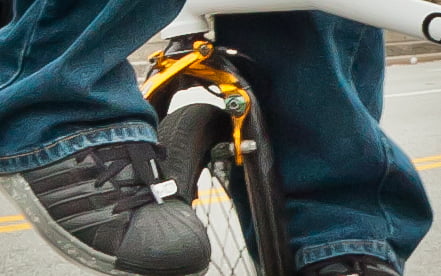
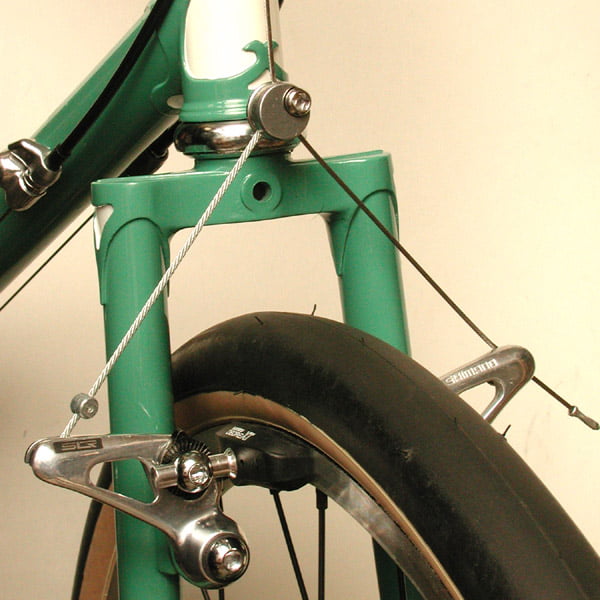
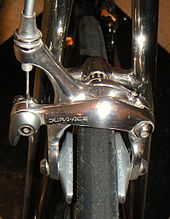

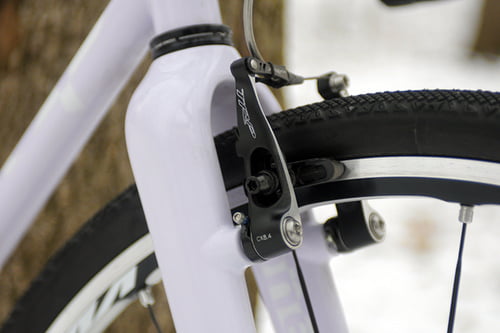

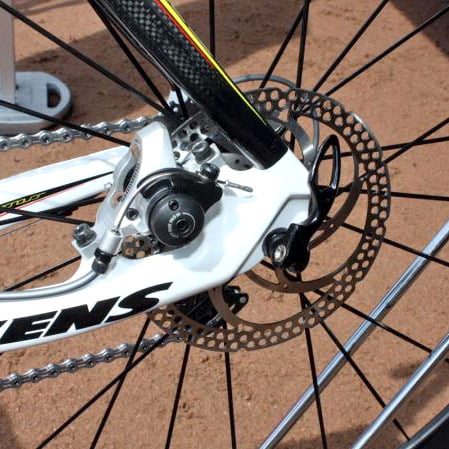

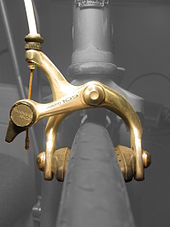
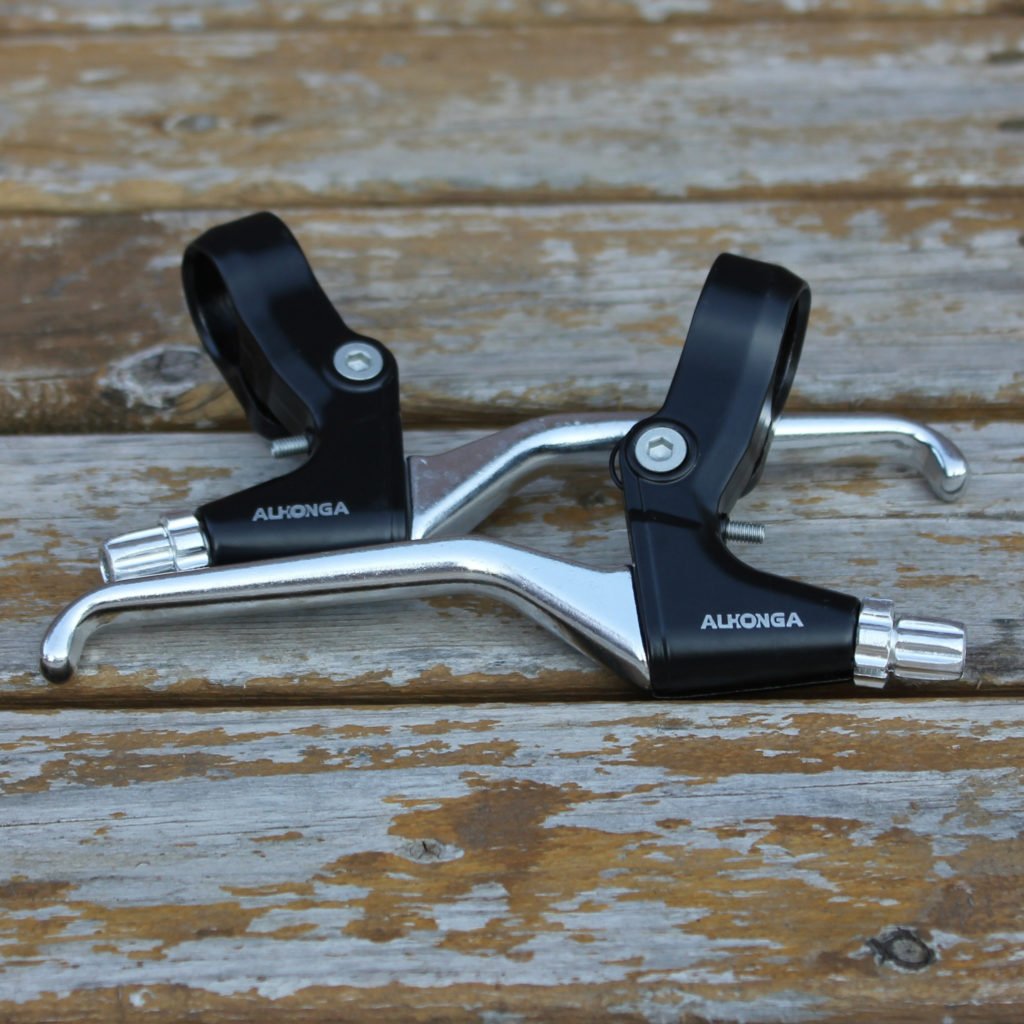
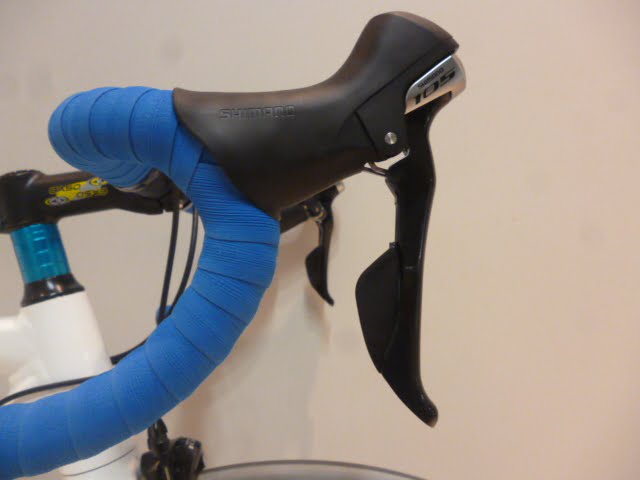
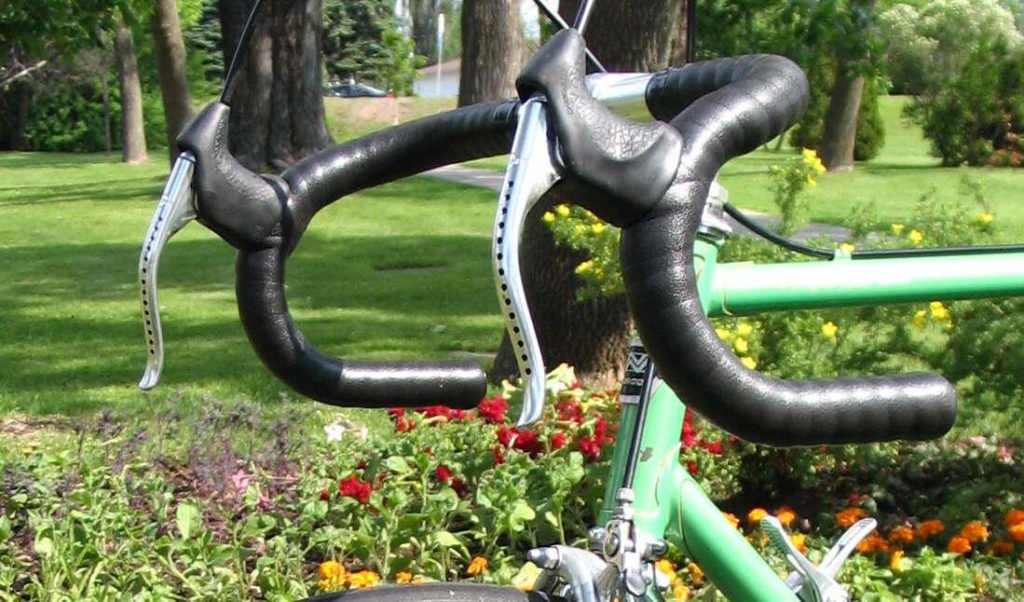
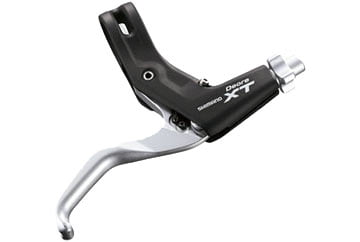
5. Mini V-brake caveats
As was nicely noticed and mentioned in Drew’s comment, some things were left unclear about the (mini) V-brakes. Not all the “Mini V-brakes” were created equal! Let me explain.
- “V-brake” is Shimano’s marketing term, the technical term for such brake design is “linear-pull brakes” (or “direct-pull brakes”).
- “Mini V-brake” is a jargon term for V-brakes with short(er) calliper arms. See the picture below:
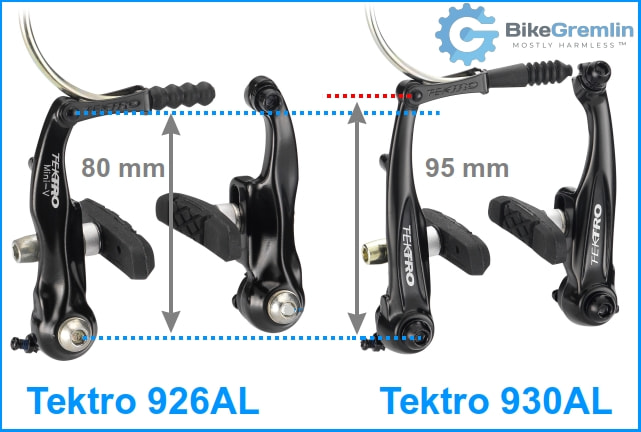
The above-depicted calliper arm length is what determines the optimal cable pull. The longer the brake arm, the more cable needs to be pulled by the brake lever.
What happens when these are not matched? Basically, you get poor braking. For more details, see the article called: “Mechanical bicycle brakes – working principle.”
Depending on the calliper arm length, V-brake (or linear-pull) callipers can be divided into three groups:
- Up to 80 mm – suitable for cantilever, and for old-style road brake levers.
- 85 to 90 mm – suitable for cantilever (but not perfectly), and for new road levers (Shiman SLR and similar).
- 95 mm and longer – suitable for V-brake levers.
6. Park Tool video demonstration
Park Tool has made an awesome video demonstration on this topic:
Compatibility posts are also available in eBook (printable and Kindle) and paperback editions on Amazon:

If you have any questions (or additions and corrections), please use the BikeGremlin forum’s compatibility section:
https://www.bikegremlin.net/forums/bike-compatibility/
The existing comments posted under this article (questions and answers) have been moved to this BikeGremlin forum thread:
https://www.bikegremlin.net/threads/compatibility-08-mechanical-brakes-article-comments.118/

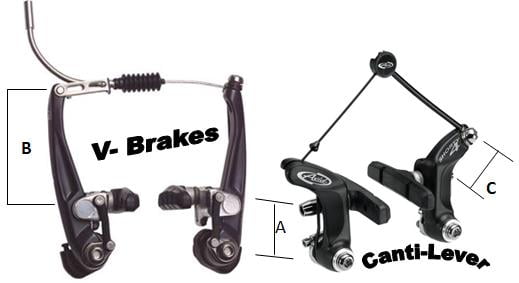
Thank you for the quick reply. My thinking with the shifting upgrade to more sprockets was to take advantage of the extra sprocket (or two) to add lower gear(s) while still keeping small jumps between gears for optimum cadence. On long steep climbs I’ve been struggling, and I’m not getting younger. The switch to Campy would be for sentimental reasons, have always been dreaming of a bike with Italian groupo. 😉
Campy parts are more expensive, which is why I’m looking to keep some of the existing pieces like brake calipers, and possibly cranks, which can make a difference, with the downside of ending up with a weird mix of parts on the bike.
Hi, excellent info. I have a basic question, I want to convert my road bike with SRAM Rival brakes and levers, to a flat bar bike. I’d like to keep the Rival calipers but what levers should I buy, I thought these would work, but reading this site I suspect they pull too much and would not work
https://www.pushys.com.au/avid-08-a-speed-dial-7-brake-lever-graphite-pair.html
Hi Ray,
The page (site) you linked to doesn’t let me visit it (it probably prevents people from my country from visiting, a very poor website-security policy resorted to by incompetent webmasters – sorry about the digression, but it is frustrating).
Flat bar brake levers that work with road bike callipers are the following:
– Cantilever brake levers (often available used / 2nd hand)
– Special road calliper compatible flat bar levers, such as Shimano Ultegra BL-R780, Tiagra BL-4700, Sora BL-R3000, Claris BL-R2000 etc – Amazon affiliate links (these are also cantilever-compatible, just sold/marketed for a different use-case).
Shimano used to make flat-bar levers with an adjustable cable-pull ratio, so one can choose to configure them either for V-brakes, or for cantilever/road callipers. I have such (decades old) levers on my commuter. I’m not sure if the above-listed models have that option (Shimano claims they are also V-brake compatible, but I don’t see a way to adjust the cable attachment position for making them pull more cable).
Thank you, I appreciate your response.
Hi, how much cable is pulled by SRAM Force cable brake levers? Your guide only mentions Shimano standards. I want to know if they are compatible with TRP Hy/Rd calipers. I have installed them but I can pull the levers all the way to the bar and they still don’t engage properly.
I haven’t tried that model so I don’t know. Manufacturer swears they are “functional with all existing lever and shifter/lever combinations.”
TRP HY/RD are hydraulic calipers actuated via cable – so they aren’t really mechanical brakes. If the calipers don’t go out sufficiently (and remain so) after several pumps of the lever, I would start looking at their adjustment options:
They have a barrel adjuster to remove any cable slack (similar to how mechanical disc brakes work). Before doing that, i.e. before threading the cable in, according to the TRP HY/RD user manual, you should push and thread in the lever arm lock nob (I don’t know if that affects the brake caliper’s travel in a way to achieve the optimal lever pull brake actuation/pad disc contact point).
If you’ve installed and configured it properly, and cable slack removal using the barrel adjuster doesn’t help (i.e. the brakes still bite only when the levers are all the way to the bars), I’d check the level of brake fluid in the calipers.
Relja
Hello Relja,
Great article I didn’t even hope to find online. I wanted to add on my cheap second hand steel frame racing bike double pivot calipers, but had the suspect something wasn’t going to work as I hoped, as the levers seemed to have a much longer pull than my previous racing bike with 9 speed indexed Campagnolo gears and brakes.
And I was indeed right.
Well, my down-to-earth thought: if newer calipers need less pull, can I simply modify the levers drilling holes for the part that hold the cable end? Making these holes a tad closer to the fulcrum of the brake lever?
Yes, the ideal should be to buy levers and brakes together, but then I would also like indexed gear and I ain’t gonna buy two sets of levers… indexed gears need also a new transmission set, likely cranks, chainrings, changing the 6 speed freewheel to indexed gears means a different hub which will be wider too, so I will need to cold set the steel frame to accommodate a more modern wheel. And all this seems a bit excessive, all in one go, considering that for now I just want to have more braking power and better pads.
So, do you think that my plan to change the pull action of the brake levers would work? They are bent-to-shape alloy Sulky levers, with a transversal cable retainer that is held in place as it has a pin each side that go into two concentric holes each side of the lever.
Picture to show how they look like:
https://scontent.fmad17-1.fna.fbcdn.net/v/t39.30808-6/345322475_963864481465483_4852641663135267481_n.jpg
I want to drill a hole above where it is now, closer to the fulcrum of the lever.
Thanks in advance,
Luca
Hi Luca,
If your calipers need less cable pull than your levers provide, then sure, technically, reducing the pivot point’s “lever” length (by making the cable attachment be closer to the pivot) will reduce the amount of levers’ cable pull.
My commuter bike (with flat bars) has levers with an adjustable pivot point. Here’s the picture (I could not open your picture from the link):

Now, if you drill the levers, my main concern is whether their strength/integrity might be compromised. Brakes are a critical safety component. I suppose you could give it a go, test it with some hard pulls, and then keep an eye on it, see if there are any cracks emerging.
Also, make sure whether you need more or less cable pull. If memory serves me well, modern road calipers require a bit more cable pull compared to the old ones.
Relja
Hi Relja,
Thanks for your reply, I tried to link it up but the URL expired, how do you embed pictures like that? This time it should work: https://ibb.co/gm5ZMCB
Anyway, perhaps again I will just start collecting parts until I have for example e set of levers and brakes, and doesn’t matter if they are with indexed shifters built in; I will abandon the down tube ones once I will have proper derailleurs and a compatible rear wheel
Hi Luca,
This time the picture loaded fine. Thank you. 🙂
That kind of levers might work OK with modern road brake calipers – they are definitely worth giving it a try at least to see if it’s good enough.
I’m a big fan of down tube shifters, especially those that can work in friction mode – they are indestructible. 🙂
P.S.
Regarding images:
The site lets me add and edit HTML as I like, while that is not allowed for visitors commenting (for spam prevention and security reasons – there are just too many abuse attempts on a daily, even hourly basis). I see you’ve figured it out, but if it helps anyone else, I wrote a tutorial that works for the site, and for bikeforums.net: 🙂
How can I add images to a comment?
Will try to add a link to that tutorial near the comment box.
Relja
Thanks Relja,
Yes, these are friction and work well, but I also like the precision and the smoothness of modern indexed gears, especially if it is a system I assembled and adjusted myself.
And I’d honestly like a 1× system on this bike but I have to study them well (chain widths, chain line and things, to see what I can mix and match). Of them, I am not keen on the mountain bike-like chain ring at the front: when I had my last bike, a Raleigh frame I built as single speed with parts bin components, I reused the cranks of my previous racing bike, single ring, and it had a 52/14 ratio 😄
https://ibb.co/rfjtDKx
Sorry for the mock up artisanal lenticular wheel, on my bike I will soon make it nicer and lighter! 😄